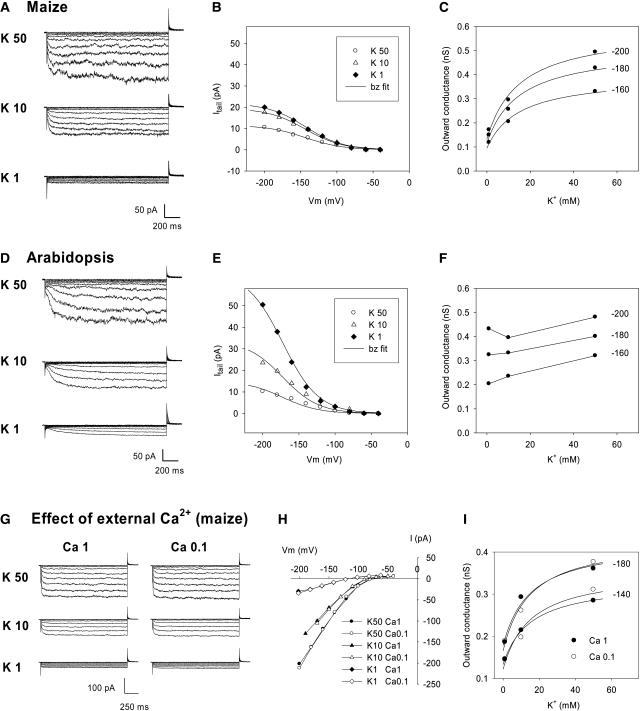Figure 7.
Effect of External K+ Concentration on Maize and Arabidopsis Guard Cell Inwardly Rectifying Channel Activity.
(A) and (D) Typical current traces recorded in maize (A) and Arabidopsis (D) guard cell protoplasts in bath solutions successively containing 50, 10, and 1 mM K+ (decrease in K+ concentration adjusted at the osmotic level with mannitol). The internal K+ concentration was 125 mM. The voltage-clamp protocol was identical to that described for Figure 5.
(B), (C), (E), and (F) Analysis of deactivation currents in maize ([B] and [C]) and Arabidopsis ([E] and [F]). Data presented in (B) and (C) (and [E] and [F], respectively) were obtained from the recordings shown in (A) (and [D], respectively).
(B) and (E) Deactivation (tail) currents measured 10 ms after the start of the deactivation pulse, plotted versus the activation potential. Solid lines are Boltzmann (bz) fits.
(C) and (F) Outward macroscopic conductance (GKout = Itail/(E – EK)) at 0 mV plotted versus external K+ concentration (see legend to Figure 5). Conductance values were calculated for the three activation potentials −200, −180, and −160 mV. In (C), the data were fitted (solid lines) based on the assumption that the conductance results from the activity of two kinds of voltage-gated channels: ZmK2.1-like channels displaying regulation by external K+ with the same Km as that determined for ZmK2.1 in COS cells (15 mM; see Figure 5D and text), and channels not regulated by external K+, providing a constant contribution to the conductance over the entire K+ concentration range.
(G) to (I) Effect of external Ca2+ on inwardly rectifying channel activity in maize guard cells.
(G) Comparison of protoplast inward current in bath solutions containing either 1 or 0.1 mM Ca2+. The bath K+ concentration was successively 50, 10, and 1 mM. The voltage-clamp protocol was as described for (A).
(H) Effect of external Ca2+ on I/V relationships at steady state.
(I) Effect of external Ca2+ on the outward macroscopic conductance at 0 mV (same analysis as described for [C]).

